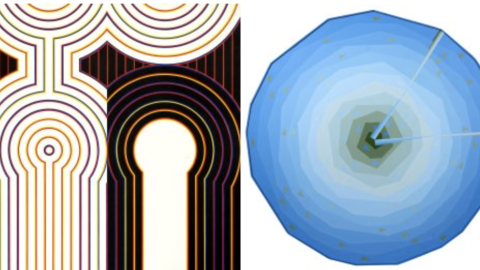The Mathematical Institute is delighted to be hosting a major exhibition of artist Kathleen Hyndman's mathematically inspired work.
The exhibition of drawings and paintings illustrate Hyndman’s desire to see nature and the world around her in mathematical sequences and geometrical patterns. Golden Section proportions and angles, prime numbers as well as Fibonacci numbers and eccentric constructions are all used to create works achieving a calm and balanced unity.
Nonlinear dynamics of passive and active particles in channel flows
Abstract
The motion of a particle suspended in a fluid flow is governed by hydrodynamic interactions. In this talk, I will present the rich nonlinear dynamics that arise from particle-fluid interactions for two different setups: (i) passive particles in 3D channel flows where fluid inertia is important, and (ii) active particles in 3D channel flows in the Stokes regime (i.e. without fluid inertia).
For setup (i), the particle-fluid interactions result in focusing of particles in the channel cross section, which has been exploited in biomedical microfluidic technologies to separate particles by size. I will offer insights on how dynamical system features of bifurcations and tipping phenomena might be exploited to efficiently separate particles of different sizes. For setup (ii), microswimmers routinely experience unidirectional flows in confined environment such as sperm cells swimming in fallopian tubes, pathogens moving through blood vessels, and microrobots programed for targeted drug delivery applications. I will show that our minimal model of the system exhibits rich nonlinear and chaotic dynamics resulting in a diverse set of active particle trajectories.
Cell-bulk compartmental reaction-diffusion systems: symmetry-breaking patterns with equal diffusivities and diffusion-Induced synchrony.
Abstract
We investigate pattern formation for a 2D PDE-ODE bulk-cell model, where one or more bulk diffusing species are coupled to nonlinear intracellular
reactions that are confined within a disjoint collection of small compartments. The bulk species are coupled to the spatially segregated
intracellular reactions through Robin conditions across the cell boundaries. For this compartmental-reaction diffusion system, we show that
symmetry-breaking bifurcations leading to stable asymmetric steady-state patterns, as regulated by a membrane binding rate ratio, occur even when
two bulk species have equal bulk diffusivities. This result is in distinct contrast to the usual, and often biologically unrealistic, large
differential diffusivity ratio requirement for Turing pattern formation from a spatially uniform state. Secondly, for the case of one-bulk
diffusing species in R^2, we derive a new memory-dependent ODE integro-differential system that characterizes how intracellular
oscillations in the collection of cells are coupled through the PDE bulk-diffusion field. By using a fast numerical approach relying on the
``sum-of-exponentials'' method to derive a time-marching scheme for this nonlocal system, diffusion induced synchrony is examined for various
spatial arrangements of cells using the Kuramoto order parameter. This theoretical modeling framework, relevant when spatially localized nonlinear
oscillators are coupled through a PDE diffusion field, is distinct from the traditional Kuramoto paradigm for studying oscillator synchronization on
networks or graphs. (Joint work with Merlin Pelz, UBC and UMinnesota).
Mathematical modeling of some aspects of Age-related Macular Degeneration (AMD)
Abstract
Our visual perception of the world heavily relies on sophisticated and delicate biological mechanisms, and any disruption to these mechanisms negatively impacts our lives. Age-related macular degeneration (AMD) affects the central field of vision and has become increasingly common in our society, thereby generating a surge of academic and clinical interest. I will present some recent developments in the mathematical modeling of the retinal pigment epithelium (RPE) in the retina in the context of AMD; the RPE cell layer supports photoreceptor survival by providing nutrients and participating in the visual cycle and “cellular maintenance". Our objectives include modeling the aging and degeneration of the RPE with a mechanistic approach, as well as predicting the progression of atrophic lesions in the epithelial tissue. This is a joint work with the research team of Prof. M. Paques at Hôpital National des Quinze-Vingts.



